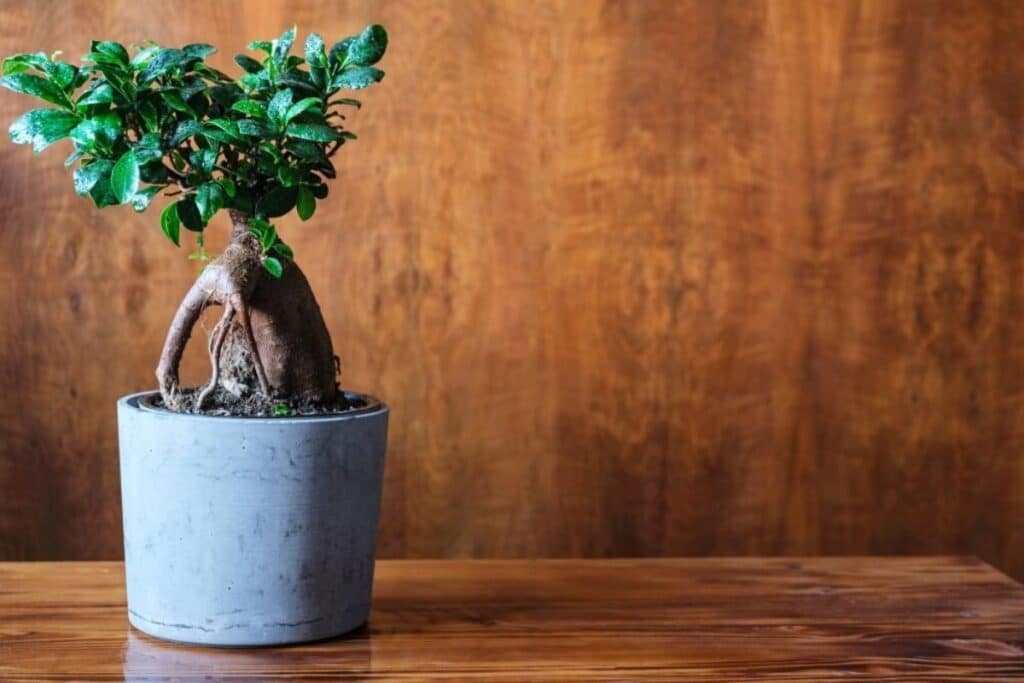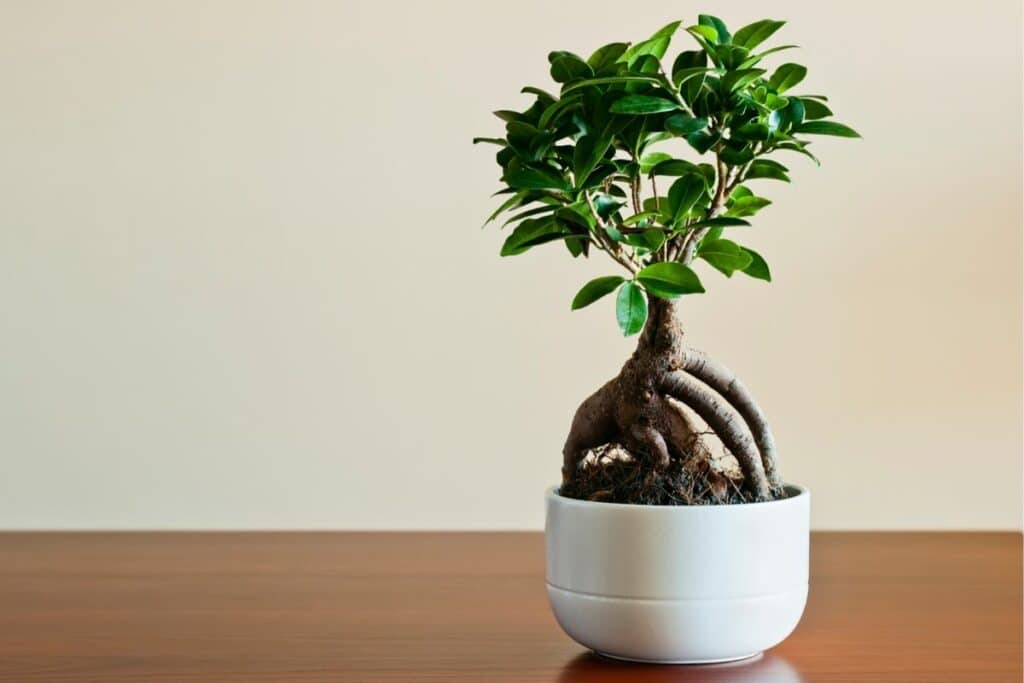If you’re new to growing bonsai, the thought of the task might seem overwhelming. Luckily, there are some plants that seem as though they are tailored for beginners.
One of those plants in the Ficus bonsai. The ficus genus is part of the extensive family of mulberry plants and is one of the most popular indoor species of bonsai specimens.
With roughly 800-2000 ficus species on the planet, ficus trees are adaptable and well-suited for being kept in indoor conditions.
Here’s everything you need to know about growing the ficus bonsai.
Interesting Facts about Ficus Bonsai
Height: 3 feet
Width: 6 inches
Sunlight: Full, direct sun
Flowering Time Length:
Lifespan: 100+ years
Scientific name: Ficus Retusa
Types of Ficus Bonsai
Ficus Retusa Bonsai

You will find hundreds of types of ficus as you begin searching for plants, but the best species for bonsai is the Ficus Retusa. This plant has a trunk that curves in an s-shape along with deep, dark green leaves that are oval-shaped.
Some other varieties, most of which are quite similar in nature to Ficus Retusa, include the Willow leaf, Tigerbark, Microcarpa, Golden Gate, Benjamina, Religiosa, and Taiwan varieties of Ficus bonsai.
Ginseng Ficus bonsai
Another option is the Ficus ginseng. Like the common ginseng root with which you are already familiar, the Ficus ginseng has a thick trunk and is often grafted with Ficus microcarpa.
What all Ficus bonsai have in common is that they have a milky latex sap. This leaks from any cuts in the plants. In addition, all tropical figs are evergreens, with many producing nice flowers that sometimes hideout of plain sight.

Growing Ficus Bonsai from Seed or By Propagation
Ficus bonsai can be grown from seed or by propagation. If you decide to plant from seed, do this in the spring. If you choose to plant cuttings, you will want to use midsummer growth, while air-layering is best done in the early spring.
Ficus Bonsai Care Guide
Here are useful tips how to care for bonsai trees:
Sunlight
The Ficus bonsai tree must be kept indoors in most locations, as it cannot handle even a light frost. You may have some success keeping this plant outside in the summer, as long as temperatures remain above 60 degrees.
You will need to provide this tropical tree species with plenty of light. Full sun is best, both for plants that are grown indoors as well as those that grow outside. Shade is not ideal under any circumstances.
Watering
While Ficus bonsai is very particular when it comes to sunlight, that is not necessarily the case when it comes to water. You can water this indoor tree species just as you would almost any other bonsai specimen. Simply water whenever the soil is too dry.
If you happen to over- or underwater this plant on occasion, don’t panic! It’s not the end of the world.
Providing Ficus bonsai with water that is room temperature and somewhat soft is ideal. You can also mist daily, which will help maintain proper humidity. This can also prevent problems related to overwatering, such as root rot and other fungal issues.
Since you must position the Ficus bonsai in a bright, warm location, it will dry out more quickly, even in the winter.
Fertilizing
You can fertilize your Ficus bonsai once a week or even once every other week during the summer. In the winter, if the ficus bonsai plant doesn’t go dormant, you can fertilize every two to three weeks. You can use organic pellets or liquid fertilizer to get the job done.
Potting and Repotting
Ficus bonsai should be repotted every other year. You can use a basic soil mixture to do this.
This indoor bonsai does well with root pruning, so you may want to do this when it comes time to repot your plant, too.
Pruning a Ficus Bonsai
Over time, it will become necessary for you to prune your Ficus bonsai. You only need to prune back to two leaves after six to eight have developed. This can reduce leaf size and help the plant put on more vigorous growth. If you want the trunk to become thicker, let the plant grow freely for two years.
You’ll have to cut more intensely and deeply after letting the plant put on this much growth, but don’t worry – these cuts shouldn’t affect the health of the plant. New shoots will grow from older wood.
Occasionally, you may also need to wire your plant. Wires need to be checked often as they can cut into the bark.
Pests and Diseases
These bonsai ficus trees are very resistant to pests, but there are a few problems that can occur depending on where you live. For example, both dry air and too little light can weaken the plant and leave it more susceptible to leaf drop.
When a plant becomes weak, it’s also more likely to suffer from issues like spider mites or scale. Usually, misting the leaves is a good way to prevent serious problems. You can also increase the amount of light to which your plant is exposed.
Where to Buy Ficus Bonsai
You can purchase Ficus bonsai from just about any nursery or home store. They are usually sold as potted plants or specifically as bonsai. Just be careful purchasing bonsai that seem cheap. Often, these plants bring a ton of problems along with them, like scars and poorly grafted branches.
Instead, you’re best off purchasing a Ficus bonsai from a reputable bonsai trader that specializes in these kinds of plants. You’ll find healthy and well-styled plants from these sources.
FAQs
Does Ficus bonsai need sunlight?
Yes, Ficus bonsai trees require sunlight to thrive. They prefer bright, indirect light and can tolerate some direct sunlight. Adequate light is essential for their growth and overall health.
How often do you water Ficus bonsai?
The frequency of watering a Ficus bonsai depends on factors like the size of the bonsai pot, the type of soil, and the specific conditions of the environment. It’s crucial to allow the soil to partially dry out between waterings and avoid overwatering, which can lead to root rot.
Where is the best place to put a Ficus bonsai tree?
The best place for a Ficus bonsai tree is in a location with bright, indirect light. Avoid placing it in drafty areas or in direct, intense sunlight for extended periods.
What are the disadvantages of a Ficus bonsai tree?
Disadvantages of a Ficus bonsai include sensitivity to changes in environmental conditions, such as drafts or sudden temperature changes. They may also drop leaves when adjusting to a new environment. Additionally, Ficus bonsai trees can be prone to pests like spider mites and scale insects. Regular care and attention to their specific needs can help mitigate these challenges.
Final thoughts
In conclusion, Ficus bonsai cultivation and care require a delicate balance of attention and patience, making it an engaging pursuit for bonsai enthusiasts. The process of shaping, pruning, and nurturing these miniature fig trees not only promotes their health but also allows for the expression of artistic creativity.
Bonsai enthusiasts will find joy in observing the gradual transformation of their Ficus bonsai as it evolves into a harmonious and aesthetically pleasing representation of nature. With proper care, these miniature marvels can bring a sense of tranquility and beauty to any bonsai collection.
*Photo by Photo-Jope&MKhamidulina/depositphotos







